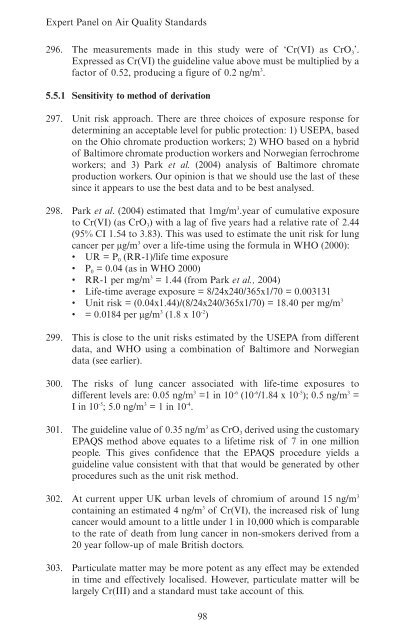Guidelines for Metals and Metalloids in Ambient ... - ARCHIVE: Defra
Guidelines for Metals and Metalloids in Ambient ... - ARCHIVE: Defra
Guidelines for Metals and Metalloids in Ambient ... - ARCHIVE: Defra
Create successful ePaper yourself
Turn your PDF publications into a flip-book with our unique Google optimized e-Paper software.
Expert Panel on Air Quality St<strong>and</strong>ards<br />
296. The measurements made <strong>in</strong> this study were of ‘Cr(VI) as CrO 3 ’.<br />
Expressed as Cr(VI) the guidel<strong>in</strong>e value above must be multiplied by a<br />
factor of 0.52, produc<strong>in</strong>g a figure of 0.2 ng/m 3 .<br />
5.5.1 Sensitivity to method of derivation<br />
297. Unit risk approach. There are three choices of exposure response <strong>for</strong><br />
determ<strong>in</strong><strong>in</strong>g an acceptable level <strong>for</strong> public protection: 1) USEPA, based<br />
on the Ohio chromate production workers; 2) WHO based on a hybrid<br />
of Baltimore chromate production workers <strong>and</strong> Norwegian ferrochrome<br />
workers; <strong>and</strong> 3) Park et al. (2004) analysis of Baltimore chromate<br />
production workers. Our op<strong>in</strong>ion is that we should use the last of these<br />
s<strong>in</strong>ce it appears to use the best data <strong>and</strong> to be best analysed.<br />
298. Park et al. (2004) estimated that 1mg/m 3 .year of cumulative exposure<br />
to Cr(VI) (as CrO 3 ) with a lag of five years had a relative rate of 2.44<br />
(95% CI 1.54 to 3.83). This was used to estimate the unit risk <strong>for</strong> lung<br />
cancer per µg/m 3 over a life-time us<strong>in</strong>g the <strong>for</strong>mula <strong>in</strong> WHO (2000):<br />
• UR = P 0 (RR-1)/life time exposure<br />
• P 0 = 0.04 (as <strong>in</strong> WHO 2000)<br />
• RR-1 per mg/m 3 = 1.44 (from Park et al., 2004)<br />
• Life-time average exposure = 8/24x240/365x1/70 = 0.003131<br />
• Unit risk = (0.04x1.44)/(8/24x240/365x1/70) = 18.40 per mg/m 3<br />
• = 0.0184 per µg/m 3 (1.8 x 10 -2 )<br />
299. This is close to the unit risks estimated by the USEPA from different<br />
data, <strong>and</strong> WHO us<strong>in</strong>g a comb<strong>in</strong>ation of Baltimore <strong>and</strong> Norwegian<br />
data (see earlier).<br />
300. The risks of lung cancer associated with life-time exposures to<br />
different levels are: 0.05 ng/m 3 =1 <strong>in</strong> 10 -6 (10 -6 /1.84 x 10 -5 ); 0.5 ng/m 3 =<br />
I <strong>in</strong> 10 -5 ; 5.0 ng/m 3 = 1 <strong>in</strong> 10 -4 .<br />
301. The guidel<strong>in</strong>e value of 0.35 ng/m 3 as CrO 3 derived us<strong>in</strong>g the customary<br />
EPAQS method above equates to a lifetime risk of 7 <strong>in</strong> one million<br />
people. This gives confidence that the EPAQS procedure yields a<br />
guidel<strong>in</strong>e value consistent with that that would be generated by other<br />
procedures such as the unit risk method.<br />
302. At current upper UK urban levels of chromium of around 15 ng/m 3<br />
conta<strong>in</strong><strong>in</strong>g an estimated 4 ng/m 3 of Cr(VI), the <strong>in</strong>creased risk of lung<br />
cancer would amount to a little under 1 <strong>in</strong> 10,000 which is comparable<br />
to the rate of death from lung cancer <strong>in</strong> non-smokers derived from a<br />
20 year follow-up of male British doctors.<br />
303. Particulate matter may be more potent as any effect may be extended<br />
<strong>in</strong> time <strong>and</strong> effectively localised. However, particulate matter will be<br />
largely Cr(III) <strong>and</strong> a st<strong>and</strong>ard must take account of this.<br />
98
















